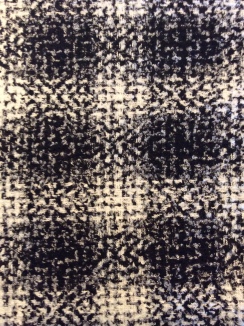[*Little Black Jacket sometimes referred to as the LFJ or Little French Jacket]
In 1954 Coco Chanel made a return to the Paris couturier scene after something of a hiatus during and immediately after the second World War. The House of Chanel had been closed for fifteen years, but now it was time to return. During her absence, Paris style had been dominated by the likes of Christian Dior whose “New Look” had created those hour-glass shapes that constricted women’s shapes nodding more to form than function – no one could truly be comfortable with a corset and bustier! Re-enter Chanel.

Before the war Chanel had already created the first sportswear that women would wear, constructed from knits & jersey’s that had never been used in women’s wear before. Her absence had seen a resurgence of constriction and she was determined to change that. So, that first season saw the birth of what we now know as the quintessential Chanel jacket.

What made it different was the construction: it was fashioned from soft bouclé fabrics and lined with silk charmeuse which is truly the most magnificent feeling against your skin. But more important than even the fabrics was the way she designed the construction. Rather than a jacket with interlining and details that made it crisp and stiff, she decided that the lining was to be quilted to the pieces of the jacket and the lining finished by hand. She was striving for luxurious comfort above all, and a jacket that was as beautiful on the inside as the outside. And the construction of the jacket to this day uses this technique. So, if one is going to pay homage to the Chanel jacket, one needs to employ her approach. Dear god…

My last report found me finally at a point where the sewing machine would make and appearance. All of the fabric and lining is now cut, marked, the soft tapes to maintain a bit of definition at the front and hemlines has been hand-stitched in place. Now the jacket pieces need to be constructed.
I use a 3.0 mm stitch length as directed by the instructor I’m following and I’m using regular thread (I may regret this) and a walking foot. This is not to be attempted without a walking foot! There are really only a few seams that need to be completed prior to the next big (quilting) step. I am remembering that the seam allowances are a full one inch! Very important to the eventual fit.
I sew the princess seams in the front pieces and the back, and put together the sleeves along the seam, making sure to use ease stitches at the point where the elbow will be. I construct the lining pieces exactly the same way. One of the most important parts of this process, though, is the pressing.
I first press the seams flat, then press them open from the inside using only the point of the iron. Then I turn the piece over and gently press each seam from the outside. The seams took terrific. I don’t trim any seams yet, though. There will be a lot of fraying and I need the depth and stability during the rest of the construction. When I am finished this process I have the following pieces: two front pieces, one back piece and two sleeves – and the same in the lining. They are all in a nice, neat pile. At the end of that lesson the instructor says, “The next step is the quilting. That’s when the fun begins!” And she smiles. Oh. My. Actual. God. The QUILTING!
I cannot remember when I have been as frustrated in a project. The process is thus: With wrong sides together, each piece of lining is machine stitched to its matching jacket piece using a 3.0 mm stitch. Each stitch line is meant to travel down a line of the ‘print’ from about two inches from the top (so that the lining is loose and I will be able to get at the side and shoulder seams in due course. The lines of machine quilting (yes, Chanel jackets are generally machine-quilted) are to be one-and-a-half to two inches apart, all done in the same direction (from the top down) and ending two inches above the hem line. Sounds simple enough. Well…
I make my plan as directed so that I know which lines I’ll follow, pin the seam lines together and use lots of other pins so that the fabrics don’t slide out of place, then begin stitching using that 3.0 mm stitch and silk thread to match the main lines of the jacket pattern – in my case, black. From the right side as directed. Oh my god… the stitches are way more visible on the outside than I want them to be! What to do?
I start unpicking hoping like hell that the stitches don’t make holes in the silk charmeuse. They’re not too bad after I press them out. So I start again. I do another test piece using various threads and stitch lengths. I ask the instructor who agrees that the pattern on the fabric with its white lines crossing black will make it very difficult for this to sink in invisibly. I note that other students are posting with their own similar concerns. No one has a real solution.


So, I do it again, using a 4.0 mm stitch and this seems to work better. I only catch the lining up in the stitching twice resulting in having to unpick twice for that reason. I only have one line that seems to have caused a bubble between it and the adjacent one, so only have to unpick for that reason once. I have to do this in several sessions so as not to either tear my hair out or rush through and make a mess.
Finally, it’s done. And it doesn’t look too bad in the end. I have all of the pieces quilted and the next step will be to stitch up the side and shoulder seams and then focus on the lining. That’s for next week! I need a martini now…
[**Please don’t take me to task for using the word ‘seamstress.’ I realize that in some people’s worlds this is a sexist term, but I think someone who sews can call herself (or himself) anything she or he wants: seamstress, sewer, sewist, tailor – you pick one, I’ll pick one today and perhaps another tomorrow. Actually at Chanel they are called ‘mains’ which of course is French for ‘hands’]




These jackets are addicting to make. Enjoy the process and please post pics of your finished work.
LikeLiked by 1 person
You are so right about being addictive! I’m just about to post about the finished product and am already looking at fabric and trim choice for the next one! I’ve already drafted the pattern for full-length sleeves and will be ready to roll as soon as I finish redrafting a pattern for a dress and then making it! Thanks for dropping by on this journey. GG
LikeLike
I am very impressed with your LBJ. I have Claire Shaeffer’s book on Couture out from the library, so I will look up what you mean about quilting the lining to the jacket. I must have missed this. Will read your entire web site. You’re doing great. You have the body for a Chanel jacket and luckily you have access to the (dwindling) retail fabrics available in Toronto. ( I lived there for 11 years and saw so many of the stores in the Fashion Area closing.) It’s even worse here in Vancouver.
LikeLike
Thanks for your kind words about my jacket! Ye, the fabric store selection even here in TO isn’t what it used to be, but it’s still pretty great! In case you missed the post on the machine quilting (which is how the original Chanel jackets are lined) here’s the link to my post on my LFJ #3’s lining. https://gloriaglamont.com/2017/09/18/lining-my-little-french-jacket/
LikeLike
I’ve read your LBJ and Cruise Collections and have signed up at your travel blog. I love everything you’re making. Your designs and fabrics suit you.
I agree – prints are hard for most of us to wear, and they hide any design details. I love design details, texture, fit, drape and clean lines.
Re cruising, my sister and I discovered Regent Cruise Lines a few years ago, so that’s now our “go to” cruise company.
I love the collar you created for your cruise day dress. After seeing Kenneth D. King show a couture suit with an extended collar, I now want to try this type of collar for a shirt, dress or jacket.
1) Do I look at your travel blog to see you wearing your Cruise Collection?
2) What kind of paper are you using for pattern making?
LikeLiked by 1 person
We’ve been on Regent twice and it is lovely, but we prefer Silversea. This coming winter, we have a couple of weeks on a Seabourn ship meandering through the islands (CAribbean) with time spent in BArbados and St. Martin on either end. I thin I might need a new collection fo that one.
I’m currently using examining table paper that I bought on Amazon although it isn’t fabulous in my view. It is slightly limper than the tracing paper I was using before (also from Amazon). I think I might splurge and try the Swiss dot pattern paper next.
As for the cruise collection in action, here is one place I wrote about it: https://gloriaglamont.com/?s=cruise+collection+in+action
LikeLike
Hi again GG. I hope you’re well. BTW I love “Gloria Junior” and your cruise collection. You know what styles, fabrics, textures and colours work for your body. I think you mentioned you have a monthly sewers group on Facebook. But when I went there I didn’t see a link to join your group.
Thanks Sandee in Chilliwack BC
LikeLiked by 1 person
Hi Sandra. The Facebook group is linked on the sidebar of the blog. But you can go directly to facebook.com/groups/12dresses and ask to join. 🙂 BTW I was born in Chilliwack, BC!
LikeLike